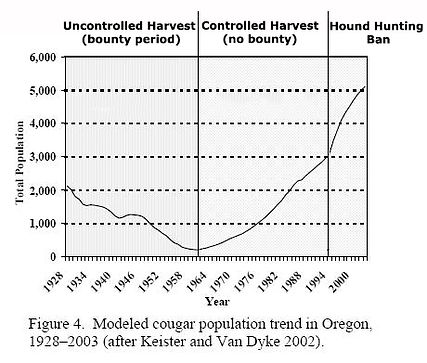Current state of cougar management and why we should hunt them
As an avid cougar hunter I often get negative feedback form the general public, both hunters and non-hunters, and I don’t blame them. We are living in a culture that hasn’t yet yet forgotten the catastrophe that was barely avoided just 70 years ago; the extirpation of cougars. What many people are not aware of is that in our extreme efforts to help cougars recover, we have overshot our goals and now cougars are killing each other and dying of disease.

In 1961 the cougar population in Oregon was estimated to be around 200 animals. In 1967 cougars were designated as “big game animals” which meant that bounties were lifted and hunting was heavily regulated. At this point cougar the cougar population quickly began recovering. By 1994, although cougar populations were sky-rocketing and ODFW’s specifications for a stable healthy cougar population had been met (3,000 cougars), the public voted to ban hunting cougars with hounds, which resulted in an even more rapid population increase. Today ODFW estimates the cougar population to be more than 6,400 cougars.
The problems with having this many cougars are many. The rapidly declining mule deer population is very high on the list for me, and should be for the population at large as we become so desperate for environmentally friendly sources of meat that we start growing it in labs. We live in an incredible country that has the potential to produce an extraordinary amount of healthy food for us. Why are we letting it go to waste?
There are many people, including our own biologists at ODFW, who are in denial about cougars effecting deer and elk populations. This is a serious problem when you have the agency created to manage our wildlife is flagrant denial of the science.
I recently heard our local predator biologist call cougar predation “compensatory” in an attempt to sweep it under the rug and pretend like the number one source of mortality for deer and elk didn’t effect the overall population. It seams the use of terms like this are just attempts to mask their personal bias in scientific verbiage and avoid confronting the facts. Just because cougar predation is natural, doesn’t mean it's compensatory. Scientists have already sorted this out, it’s these new appointed biologists who are in denial.
If you just go to ODFW’s web-page you can find multiple published experiments that demonstrate an immediate increase in deer and elk after removing some cougars form the landscape. In ODFW’s cougar management plan, and the most in-depth publication on the matter (Cougar: Ecology and Conservation by Maurice Hornocker and Sharon Negri) that cougar predation is typically compensatory UNLESS their prey is below carrying capacity and that if by removing cougars the population of deer and elk increases. This is very much the case in Oregon. Oregon's deer population size is only %50 of objective, and the objective isn’t anywhere close to the carrying capacity.
The math really is not that complicated. Based on the most recent data we have 608,244 deer/elk in Oregon. Cougars kill a deer/elk every 7 days (1 week) on average. 6,400 cougars X 52 Deer/elk = 332,800 deer/elk per year. That’s an incredible amount of predation from a single source considering wolves, bears, coyotes and everything else in the woods has to eat as well. To pretend cougar predation isn’t a driving force is either ignorant or a stall tactic because if they acknowledge the issue they would be obligated to do something about it.
Another major competing theory for the decline of deer populations is the “land use” theory. People are arguing it two ways. #1 we are building to many roads and encroaching too much. #2 that we aren't logging and grazing as much as when deer and elk were at their all time high. We have a great experiment going on right now that is proving them both false. For #1 look at the Minam unit (or any other wilderness unit) and you’ll see that land use has decreased dramatically since the 70’s, but the deer population is non-the-less still declining. For #2 look at the Sled Springs unit and you’ll see it is logged and grazed more than ever which produces vast amount of high-quality food for deer, but the deer population is non-the-less still decreasing. There’s a common denominator in both examples, heavy predation especially by cougars.
Despite the effects of irresponsibly restricted predator management in Oregon, harvesting cougars is worth while on it’s own. They yield a substantial amount of meat which is light and delicate somewhat like pork. It’s one of my favorite meats, in fact, I prefer it to deer and elk for many recipes. So in the process of doing predator control you are also harvesting food. It’s a win-win situation.
When looking at cougars at as a food source my justification for harvesting them is a little different. Cougars are a very robust species and withstand a very high level of harvest without effecting population numbers too much. Cougars are very territorial and when space, food or mates are limited, cougars kill each other for it. In areas with no hunting cougar-on-cougar fighting and infanticide is their primary cause of death. When cougars are removed by hunters, this cougar-on-cougar mortality no longer occurs. The same number of cougars die whether we harvest and eat them, or whether they kill each other and their meat goes to waste.
My argument is simply that cougar populations are at or near carrying capacity and that they can and should be be managed more aggressively not only for the sake of the deer and elk, but also to provide a great deal of recreational opportunity and some of the best meat available.